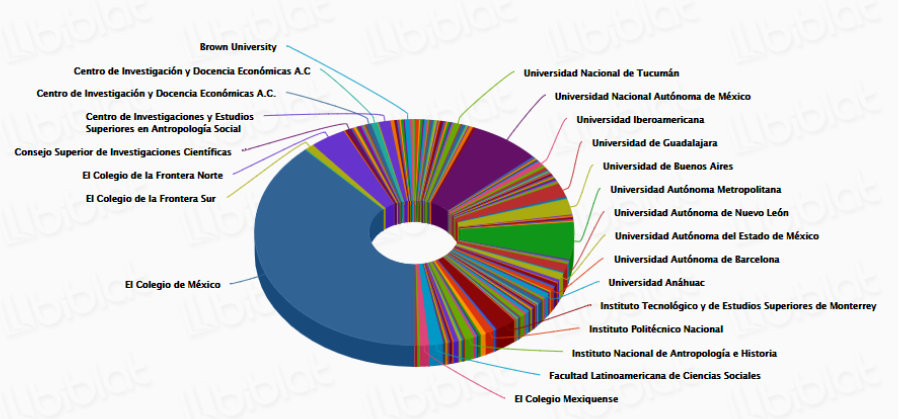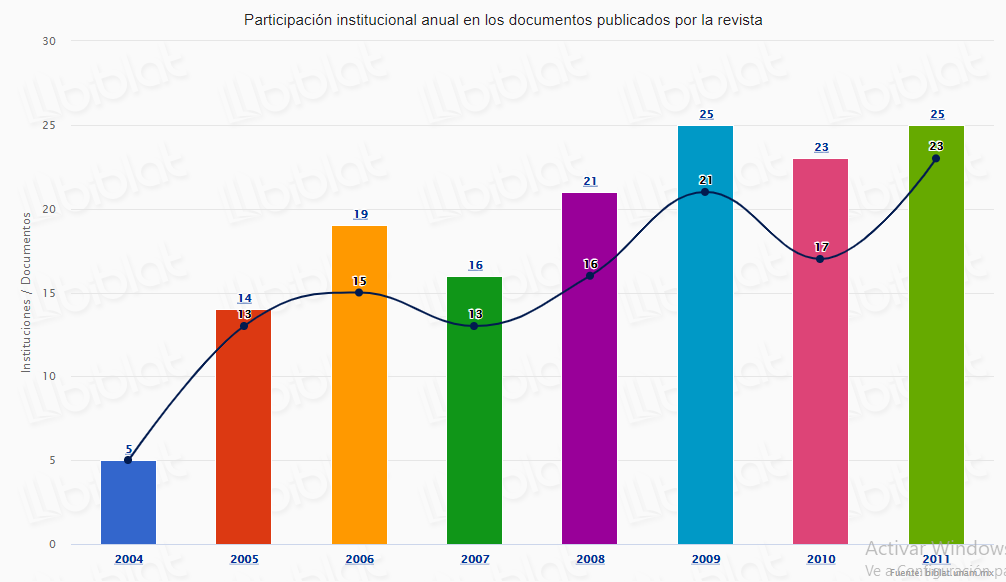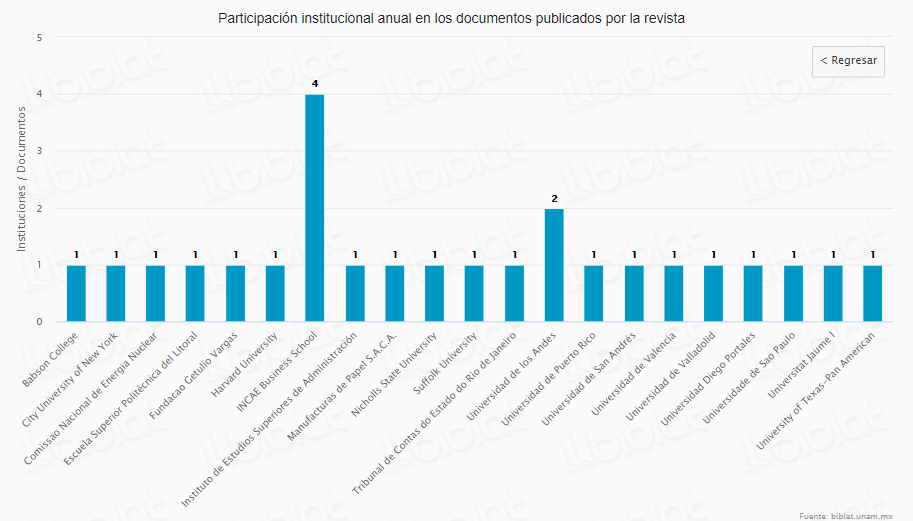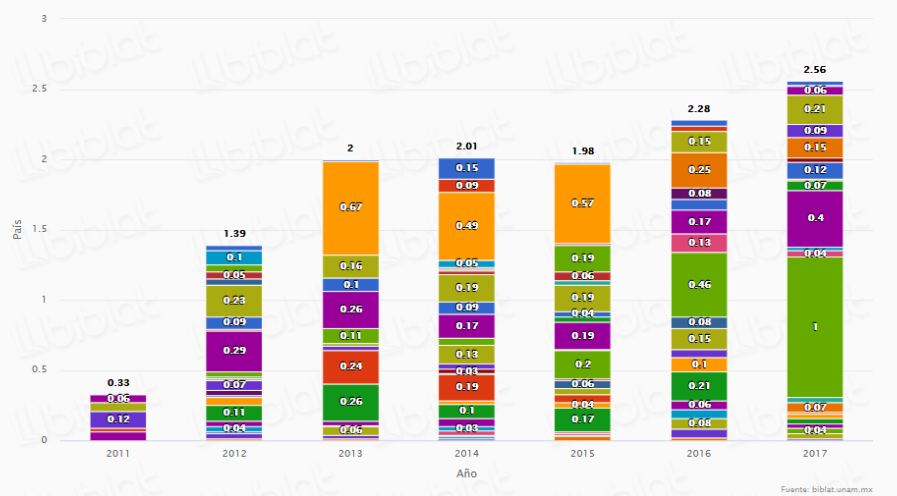Co-authorship Index
This indicator shows the average number of authors per article.
The mathematical formulation is:
Where:
Caf = Number of signing authors
Cd = Number of documents
Co-authored Documents Rate
The numeric value indicates the proportion of articles with multiple authors.
The mathematical formulation is:
Where:
Cta = Amount of documents with multiple authorship
Ctd = Amount of documents
It's interpreted that values close to 1 show more documents in co-authorship.
Degree of collaboration (Subramanyan Index)
The numeric value indicates the proportion of articles with multiple authors.
The mathematical formulation is:
Where:
Nm = Total of documents with multiple authorship.
Ns = Total documents written by a single author.
Is interpreted as values close to 0 show a strong component of single authorship, while than close to 1 denote a high proportion of multiple authorship.
Elitism Model (Price)
Identifies the number of authors who make up the elite of the most productive per journal or country of publication of the journal.
The numerical value represents the number of authors that make up such elite.
The mathematical formulation is:
E =
√N
Where:
E = Elite authors who publish 50% of works.
N = Total population of authors.
Collaboration Index (Lawani Index)
Provides the average weight of the number of authors per article.
The numerical value represents the average number of authors per article.
In addition to displaying the frequency of the number of authors per article.
The mathematical formulation is:
Where:
N = Amount documents
ji = Number of signatures (authors) per documents.
ni = Number of documents with multiple authorship.
Índice de densidad de documentos (Zakutina y Priyenikova)
Índice que muestra el promedio de artículos por cada número publicado por la revista en un año específico.
The mathematical formulation is:
Where:
Rn = ∑ Artículos publicados en un año específico.
N = ∑ Números publicados por la revista en ese año.
Índice de concentración temática(Índice Pratt)
Indicates the degree of thematic concentration of journals.
The numerical value represents the level of thematic concentration based on their descriptors.
Shows the frequency of descriptors.
The mathematical formulation is:
Where:
C = Pratt Concentration Index.
n = Number of categories
q = ∑ of the product of the frequency range of a given category, divided by the number of items in all categories.
It's interpreted that values close to 1 show more amount of specialization.
Modelo de Bradford (Revista)
Distribución de artículos por revista.
Mathematical model that identifies the core of journals with more information by subject.
Three zones are identified according to the amount of articles per journal in the discipline:
The core area, the 2nd and 3rd, the titles and the number of articles they have published.
It shows the frequency of articles per journal in the discipline.
The mathematical formulation is:
p:p1:p2:1:n1:n2
Where:
p = Number of titles per zone.
n = Multiplier or factor of proportionality of titles per area.
Modelo de Bradford (Institucional)
Distribution of articles per institutions.
Mathematical model that identifies the core of institutions with more amount of information by topic.
Three zones are identified according to the number of articles per institution in the discipline:
The core area, the 2nd and 3rd, the institutions and the number of articles they have published.
It shows the frequency of articles per institution in the discipline.
The mathematical formulation is:
p:p1:p2:1:n1:n2
Where:
p = Number of institutions by area.
n = Multiplier or proportionality factor of institutions per area.
Tasa de autoría exógena por revista
Indicator that measures the degree of internationalization of journals, considering the proportion of authors whose institutional affiliation is from a nationality other than that of the journal. Provides the exogenous productivity rate per journal and the frequency of nationality of their authors.
The numerical value indicates the proportion of foreign authors who have published in the journal.
The mathematical formulation is:
Where:
TAE = Exogenous Authorship Rate
ae = Foreign authors
d = Total documents
Documentos de una revista por institución
Es el número de documentos producidos de acuerdo a la institución de afiliación del autor.
The mathematical formulation is:
RI =
∑di
Where:
RI = Representación institucional
di = Total de documentos que pertenecen a la institución de afiliación del autor
Documentos anuales de una revista por institución
Es el número de documentos producidos anualmente de acuerdo a la institución de afiliación del autor.
The mathematical formulation is:
RI =
∑dai
Where:
RI = Representación institucional
dai = Total de documentos anuales que pertenecen a la institución de afiliación del autor
Tasa anual de autoría exógena dividida por país
Indicator that measures the degree of internationalization of journals, considering the proportion of authors whose institutional affiliation is from a nationality other than that of the journal. Provides the exogenous productivity rate per journal and the frequency of nationality of their authors.
El valor numérico indica la proporción de autores por país extranjero que han publicado en la revista.
The mathematical formulation is:
Where:
TAE = Exogenous Authorship Rate
aep = Autores extranjeros por país
dp = Total de documentos por país
Documentos de una revista por institución
Muestra el nivel de apertura institucional que tiene la revista en un periodo específico de tiempo, el tamaño del arco muestra el número de documentos por institución de afiliación del autor.

Documentos anuales de una revista por institución
Muestra la evolución en el tiempo de la representación institucional de una revista de acuerdo a la afiliación de sus autores.
La gráfica muestra en el tope el número total de las participaciones por las distintas instituciones para la elaboración de los documentos en ese año, el número al interior de estas corresponde a la cantidad de instituciones de afiliación diferentes contenidas en los documentos.

Seleccionando un año se conoce el nombre de las instituciones y la cantidad de documentos en los que participa.

Tasa anual de autoría exógena dividida por país
Este indicador es la relación entre la cantidad de autorías extranjeras de acuerdo a la nacionalidad de la revista y el total de documentos publicados en un año específico. Cuanto más cercano sea el valor a 0 significa que la revista tiene menor participación extranjera.

Si el valor obtenido es 0 significa que en ese año la revista no publicó ningún documento de autoría extranjera.
Cuanto más alto sea el valor obtenido es mayor la participación extranjera.
El valor anual del indicador aparece en el tope de cada barra de la gráfica, para cada año se muestran los países extranjeros y la proporción de su participación.
Coautoría entre países
Representación gráfica de la colaboración entre autores según el país de afiliación institucional en una revista y en un periodo de tiempo determinado.
Este indicador toma las afiliaciones institucionales de los autores para determinar el país de procedencia y formar conjuntos, los cuales se grafican en círculos (conjuntos) similares a un diagrama de Venn-Euler. Posicionándose en los conjuntos o en sus intersecciones se puede ver la cantidad de documentos que forman parte de esos conjuntos.
La información que podemos obtener de este indicador es:
Países cuyos autores publican en una revista pero sin colaboración con otros países. En la gráfica corresponde a un conjunto de un solo color que no está unido a otro ni contiene conjuntos más pequeños en su interior. Su posición cercana a otro conjunto no implica ninguna colaboración.
Países cuyos autores publican en una revista y colaboran con otros países. Este caso corresponde a los conjuntos que se intersectan entre sí. Al posicionar el cursor sobre el área de intersección se obtiene el total de documentos en los que colaboraron los países que forman parte del conjunto.
Países cuyo conjunto se encuentra dentro de otro conjunto más grande. Indica que existe una colaboración entre ambos conjuntos.